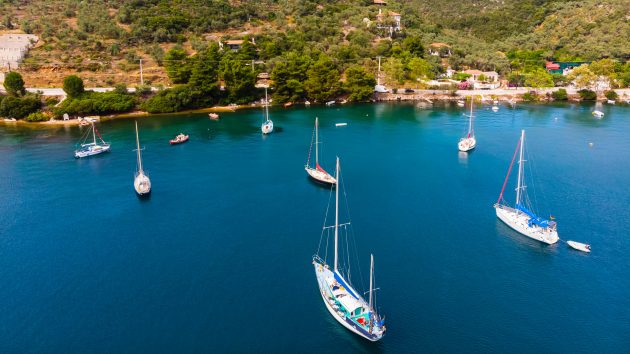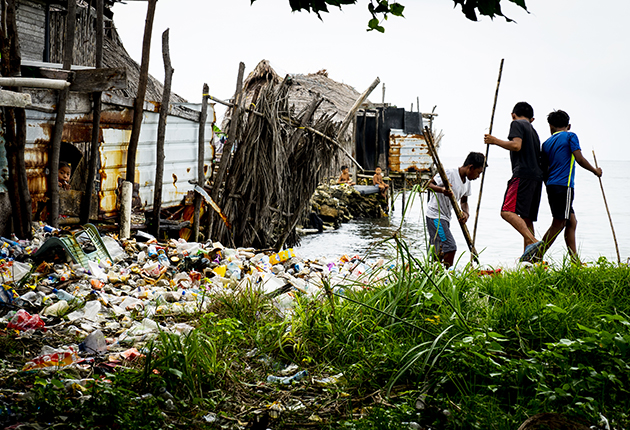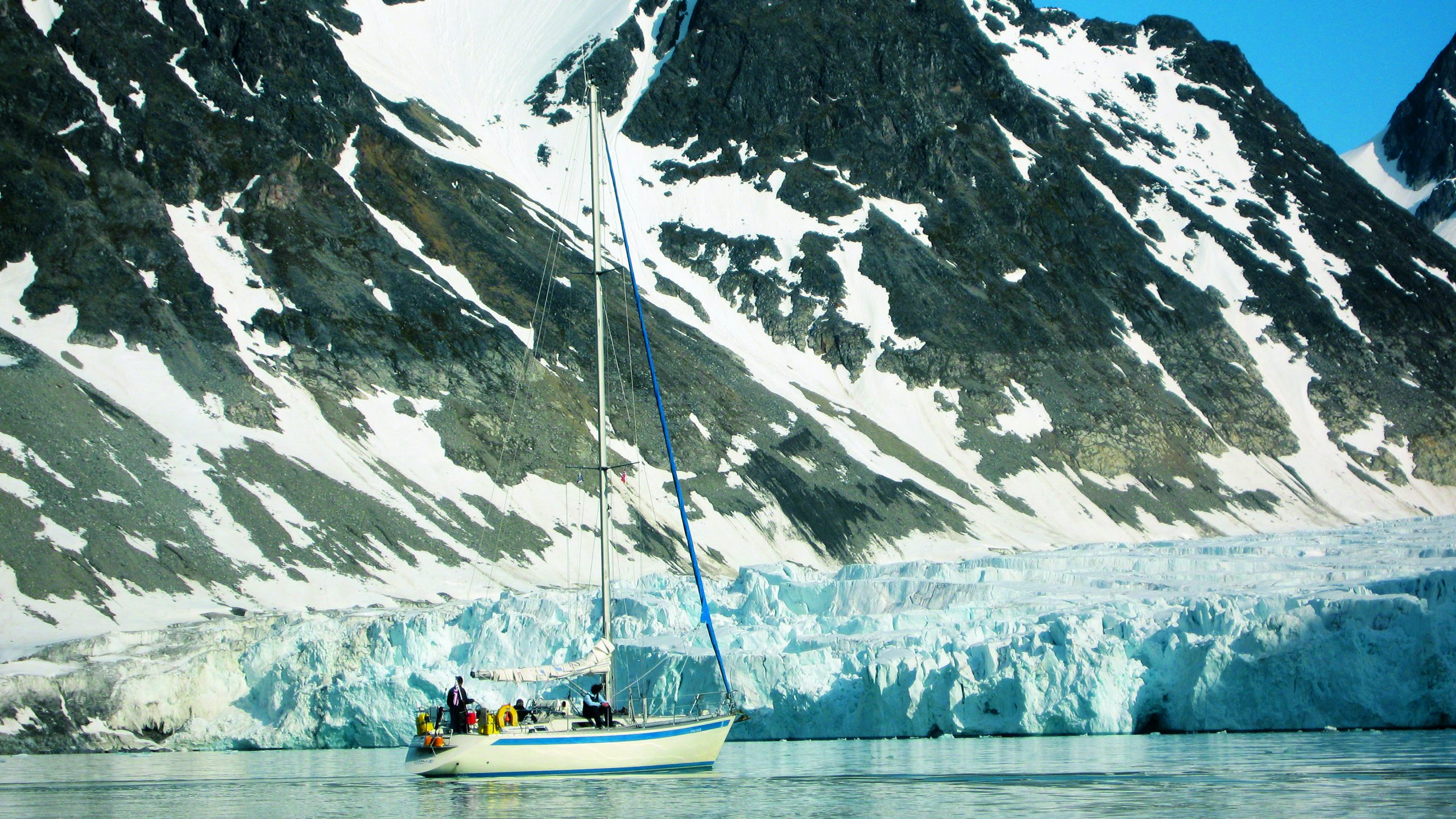As sailors, what can we do to protect the wildlife we see? Genevieve Leaper shares her experiences after discovering a dead seal while cruising Greece. The article was runner-up in the 2021 Brian Black Memorial Award
Death of a monk seal: Brian Black Memorial Award 2021 – runner up
One peaceful autumn evening we anchored off a small, uninhabited island on the way back from a short cruise around the Sporades, writes Genevieve Leaper.
The Aegean islands are quiet at this time of year and Beduin, my partner’s Nicholson 32, was alone in the anchorage.
The days were getting shorter so we jumped straight on our paddleboards to explore while it was still light.
Paddling round a low rocky headland I spotted a smooth, round shape in the water among the jagged rocks fringing the shore.
I felt a thrill of excitement – could it be the animal I’d been hoping to see for the past two years? Yes! When the round shape turned it was unmistakably the head of a seal.

The dead monk seal was a sub-adult female. Only 800 of these mammals remain, spread between the Med and the Atlantic. Credit: Genevieve Leaper
It was a big animal and reminded me of a bull grey seal. But, unlike the grey or common seals at home in Scotland, this seal was much more wary; it stared at us for a few moments, dived and disappeared.
The Mediterranean monk seal is now very rare and endangered, with a global population of about 800 animals, split between the Mediterranean and Atlantic.
The Atlantic range is now restricted to several hundred at Cap Blanc in Mauritania and a tiny isolated population in Madeira.
Once distributed throughout the Mediterranean Sea, monk seals are now found mainly in the east with about half the population in Greece.
In the past seals gathered in hundreds on open beaches, but after centuries of persecution and disturbance they have become much more secretive, resting and pupping in sea caves.

Genevieve and Aleko found the dead monk seal at Valtoudi Bay where Beduin (bottom left) is moored. Credit: Genevieve Leaper
This was my first glimpse of a monk seal in the Mediterranean, even though I’ve spent many weeks sailing in the Aegean, and the Sporades are one of their remaining strongholds.
The National Marine Park of Alonnisos and Northern Sporades, encompassing several islands and a marine area of 2,200km², was designated in 1992 largely to protect the monk seals.
Back in Milina, Aleko’s home village, a friend phoned to say there was a seal off the beach.
I hurried down to the harbour just in time to see the seal swimming past offshore. Maybe they weren’t quite so rare after all. I was really hoping for a closer view.
Wake-up call to the plight of the monk seal
A couple of weeks later, I did get a much closer look, but not in the circumstances I wished for.
The weather was perfect so we decided to set out across Valtoudi bay on the paddleboards, with lunch and a vague plan to go round Alatas island.
Aleko was ahead and I saw him stop and paddle round something in the water. As I got closer my worst fears were realised.
The dead monk seal was lying belly up, flippers neatly clasped to her chest.

The young female monk seal has been shot in the head three times. Credit: Genevieve Leaper
At first sight she seemed to be in perfect condition, unblemished except for one bulging bloodshot eye.
Then I noticed a dark spot in the water and realised it was blood dripping from a wound in the top of her head.
At that point my sorrow turned to anger – someone had deliberately killed this beautiful creature.
Up until this point the monk seal had been just another of so many threatened species in the world.
Continues below…
Polluted Paradise: Brian Black Memorial Award winner for 2021
Sophie Dingwall sees firsthand the impact of plastic pollution on the Caribbean's population. Her article - Polluted Paradise - has…
Brian Black Memorial Award 2022: £4,000 prize on offer for environmental journalism
Back for a second year, the Brian Black Memorial Award 2022 is inviting entries to celebrate the best writing about…
Coppercoat Brian Black Memorial Award: 2024 winners to be announced at Southampton Boat Show
The Brian Black Memorial Award 2024 is sponsored by Coppercoat and there is £4,000 up for grabs for the winners.…
Sailing Svalbard: an Arctic education
Sam Shrives contends with sea ice and an amorous walrus during a three-month cruise from Norway across the Barents Sea…
I was concerned about the survival of the monk seal, but in a general way. Now it was a lot more personal.
The monk seal had suddenly become a species I cared a lot about.
The next couple of hours were frustrating as we waited for the coastguard, who had asked Aleko to take them out in Beduin.
Meanwhile I hurried home to download photos I’d taken and email them to MOm, a charity for monk seal conservation.
In the end, the coastguard went out to recover the seal in a fishing boat, and told Aleko they didn’t need our help. If that was a subtle hint we ignored it – we intended to make absolutely sure that the body wasn’t just quietly buried.

The dead seal was towed to shore by the Coastguard in a fishing boat. These mammals are protected species. Credit: Genevieve Leaper
We followed on Beduin as they eventually located the body washed up on a rocky shore and towed it to the beach.
Once they had hauled the seal ashore it was obvious that she had three head wounds. We measured the body length in case no one else did and I took more photos.
The body was taken to the University of Volos for examination, which confirmed that the animal was a young female which had died from gunshot wounds.
Although I knew deliberate persecution was one of the causes of the monk seal’s decline, I somehow imagined that was a thing of the past, that the problems now were disturbance and overfishing.
Later, talking to sailing friends, we discovered that this was far from the case.

Beduin is a Nicholson 32, which Genevieve and Aleko have cruised extensively around Europe. Credit: Genevieve Leaper
One couple we know had found three dead seals over the years and also mentioned rumours of fishermen shooting dolphins.
I love the traditional Greek fishing boats with their generous curves and cheerful colours, but now I can’t look at the fishing boats in Milina harbour without wondering whether one has a gun onboard.
I’m sure most fishermen wouldn’t harm a seal but I find it hard not to view them all with suspicion.
Milina is not a big place; many people probably know who was responsible, but no one will say.
Fisherman’s foe?
We were angry, we wanted to do something – and despairing because we were powerless to prevent it happening again.
Of course, there are bigger environmental problems in the Aegean, most obviously the huge quantity of plastic pollution, which kills untold numbers of marine creatures by ingestion and entanglement every year.
This, at least, we can do something about ourselves, however insignificant our efforts seem. But what can we do to stop fishermen killing seals?

Colourful wooden fishing boats in Milina harbour. Both the monk seal and the fishermen compete for diminishing fish stock. Credit: Genevieve Leaper
Clearly the heavy penalties for killing this protected species are not an adequate deterrent.
There is, I realised, one thing we can all do – we can talk about it.
Aleko told everyone he knew in the village about the dead seal and contacted the local paper.
I circulated the photos and details to conservation organisations. Perhaps the best hope for the seals is if people realise that killing protected wildlife is bad for tourism.
And certainly any solution must involve the fishermen.
Seals are attracted to fish in nets, which is bad news for both fishermen and seals; nets can be damaged and entanglement is another major cause of seal mortality.
The conflict is exacerbated as both coastal fishermen and seals suffer from diminishing fish stocks caused by multiple factors which require bigger solutions.
Spread the word to protect the monk seal
We are also trying to encourage fellow sailors to report sightings of seals and other marine wildlife.
The first step to protecting seals is to know where they are.
My particular fear is that the Pagasetic Gulf is acting as a ‘sink’ area for the seal population in the Marine Park.
If young animals dispersing from the protected area find suitable habitat here but are being killed before they even reach breeding age, it becomes a constant drain on the population.

Monk seals are extremely rare but can still be seen swimming in Greek waters, particularly in the Sporades. Credit: Genevieve Leaper
There are sightings of seals along the Trikeri peninsula every year, often for a few days or weeks.
Perhaps they are just exploring and swim back out of the Gulf again but maybe they disappear for more sinister reasons.
Since that awful day I have seen a few live monk seals and even observed something of their natural behaviour.
At a quiet anchorage in the Marine Park, we watched for over an hour as a seal dived repeatedly in the same spot, presumably trying to extract some prey from its hiding place.
It helps to have some good memories, to eclipse the haunting image of that lovely creature lying dead in the water.

Credit: Maxine Heath
Then, last winter, Aleko heard that a seal had been shot at a fish farm a few miles from Milina. It seems the seals are not safe even within the Marine Park.
The brutal slaughter of a young seal known as Kostis with a speargun made the international press in July 2021 after the body was found on Alonnisos.
The perpetrator has not been caught, but, according to MOm, the evidence points to a deliberate, targeted killing using a very large spear.
Kostis was a rehabilitated youngster, named after the fisherman who found the pup washed up on a beach during a storm in 2018.
He was friendly, and had taken to hanging around yachts, hauling out on paddleboards and swimming with people.
Many people knew Kostis, and there has been widespread outrage at his death.
So, if you are sailing in Greece, please record sightings of marine mammals and turtles to the Archipelagos Institute of Marine Conservation at www.archipelago.gr/en/our-work/marine-mammals/ and the MOm Hellenic Society for the Study and Protection of the Monk Seal at www.mom.gr/home.
Ask about the seals, show an interest in the wildlife. If you care about the marine environment, talk about it.
And if you do see a monk seal, consider yourself very lucky indeed!
Brian Black Memorial Award sponsored by B&G

Brian Black, a television journalist and lifelong sailor and contributor to Yachting Monthly, was as passionate about the marine environment as he was eloquent in his writing and filmmaking about the crises facing fragile Arctic ecosystems.
His wife Lesley was a sailor and author in her own right, becoming Northern Ireland’s first female yacht club commodore.
As a memorial to Brian and Lesley Black, the Black family, in conjunction with YM, established an award to celebrate sailing adventures which shed a fresh light on marine environmental issues through inspiring journalism.
The award aims to recognise the very best writing about the marine environment that brings a new perspective to readers.

The award is sponsored by marine electronics company B&G, which recognises sustainability as one of the pillars of its multi-year strategy.
B&G’s sustainability agenda includes: removing all single- use plastics from its packaging and using only recyclable materials from this year; reducing company air travel by 90%; reducing paper used in their offices by 95%; and decreasing energy consumption for IT equipment from 305,000kWh to 250,000kWh.
It is also working with sister company C-Map to open up their BioBase platform, which processes, maps and stores spatial aquatic data free of charge to government bodies and research institutes, to support aquatic conservation. www.bandg.com
For more details on the Brian Black Memorial Award 2022 visit: www.yachtingmonthly.com/bbma2022
Enjoyed reading this article?
A subscription to Yachting Monthly magazine costs around 40% less than the cover price.
Print and digital editions are available through Magazines Direct – where you can also find the latest deals.
YM is packed with information to help you get the most from your time on the water.
-
-
- Take your seamanship to the next level with tips, advice and skills from our experts
- Impartial in-depth reviews of the latest yachts and equipment
- Cruising guides to help you reach those dream destinations
-
Follow us on Facebook, Twitter and Instagram.








